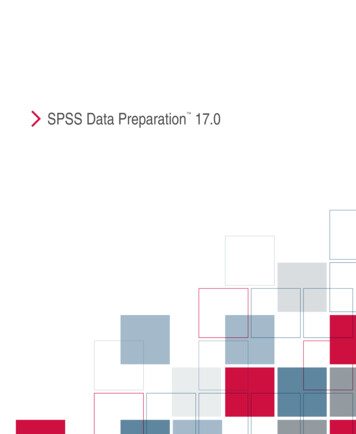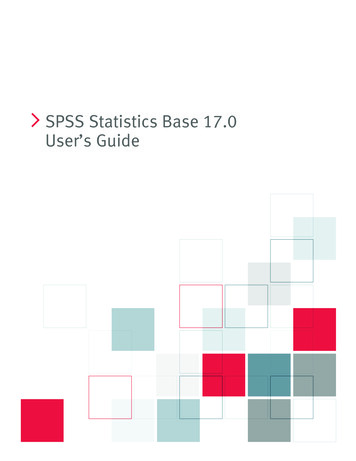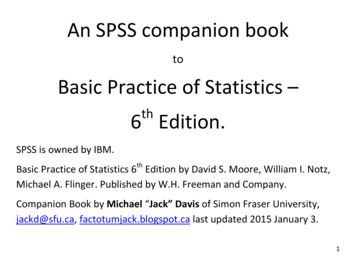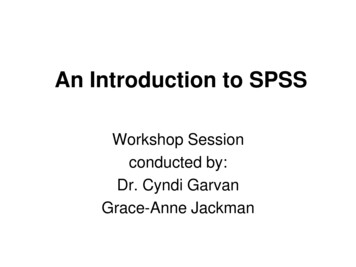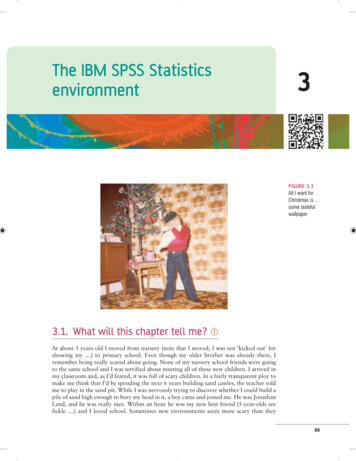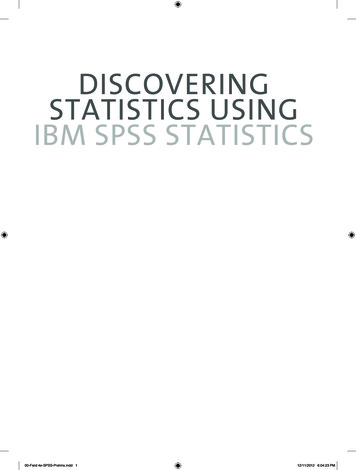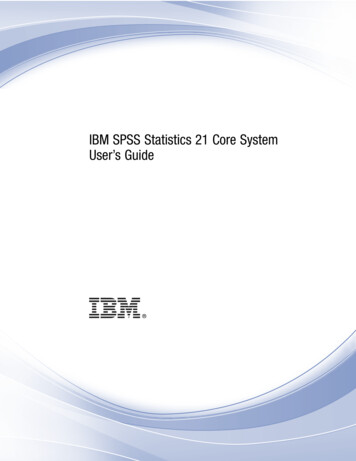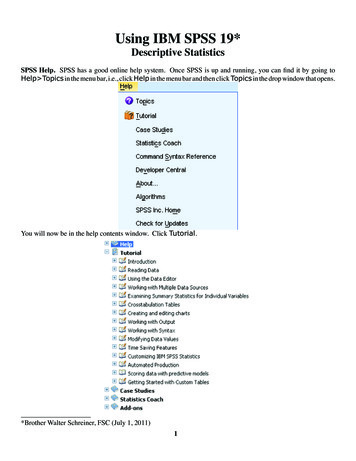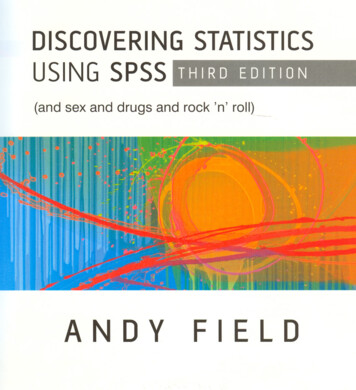
Transcription
DISCOVERINGUSING SPSSSTATISTICSTHIRDEDITION(and sex and drugs and rock 'n' roll)ANDYFIELD
CONTENTSPrefacexixHow to use this xxxiused in this bookxxxiiiSome maths revision1Why is my eviL Lecturer forcing me to Learn statistics?11.1.What will this chapter tell me?11.2.What the hell am I doing here? I don't belong here1.2.1.The research process D1.3.Initial observation:1.4.1.5.Generating theories and testing them DData collection 1 : what to measure D1.6.1.7.finding something1.5.1.Variables D1.5.2.Measurement error D1.5.3.Validity and reliability DData collection2 D D2: how to measurethat needs explaining D33477101112 D1.6.1.Correlational research methods D121.6.2.Experimental research methods D131.6.3.RandomizationAnalysingdata17 D18 D181.7.1.Frequency distributions1.7.2.The centre of a distribution1.7.3.The dispersion in a distribution1.7.4.Using a frequency distribution to go beyond the data1.7.5.Fitting statistical modeis to the dataWhat have I discovered D20 D23 D Dabout statistics? D D242628Key terms that I've discovered28Smart Alex's stats quiz29Further reading29Interesting30real research
DISCOVERINGvi2STATISTICS312.1.What will this chapter tell me?2.2.Building statistical2.3.Populations2.4.Simple statistical32CD34CDmodeis35CDThe mean a very simple statistical model2.4.2.Assessing the fit of the mean: sums of squares, variance and standarddeviations CD35 38Expressing the mean as amodel4040Confidence intervals 43Using statistical modeis to test research questionsTest statistics CD2.6.1.2.6.2.One- and two-tailed tests2.6.3.2.6.4.Type I and Type II errors CDEffect sizes 2.6.5.Statistical power58about statistics?59CD59Smart Alex's stats quiz59Further reading60Interesting60real research61The SPSS environment3.3.3.4.48525556Key terms that I've discovered3.2.CD54CD What have I discovered3.1.35CDGoing beyond the data CD2.5.1.The standard error CD2.5.2.2.6.mod eisand samples31CD2.4.1.2.4.3.2.5.What will this chapter tell me?Versions of SPSS CDGetting startedThe data editor61CD6262CD63CD3.4.1.Entering data into the data editor3.4.2.The 'Variable View'69CD70CDCD773.6.The SPSS SmartViewer813.7.The syntax window @823.8.Saving files8384Missing valuesThe SPSS viewer CD3.4.3.3.5.3.9.78CDCDRetrieving a fileCDWhat have I discoveredabout statistics?858585CDKey terms that I've discoveredSmart Alex's tasks86Further readingOnline tutoriais4SPSSEverything you ever wanted to know about statistics(well, sort of)3USING8687Exploring data with graphs4.1.What will this chapter tell me?4.2.The art of presentingdata87CD8888CD4.2.1.What makes a good graph?4.2.2.Ues, damned lies, and . ermCDgraphsCD90
viiCONTENTS4.3.The SPSS Chart Builder4.4.Histograms4.5.Boxplots4.6.GraphingCDa good way to spot obvious problems(box-whiskerdiagrams)means: bar charts and error barsrelationshipsthe scatterplotEditing graphs117119121CD123CD125CD126CD126CDWhat have I discovered5116CD4.8.5. Simple dot plot or density plot4.9.115CD4.8.3. Simple and grouped 3-0 scatterplots4.8.6. orop-line graph113CDCD4.8.2. Grouped scatterplot4.8.4. Matrix scatterplot111CD4.6.5. Clustered bar charts for 'mixed' designsLine charts CDGraphing107CD1094.6.3. Simple bar charts for related means CD4.6.4. Clustered bar charts for related means4.8.1. Simple scatterplot105CD4.6.2. Clustered bar charts for independent means4.8.103CD4.6.1. Simple bar charts for independent means4.7.CDCDabout statistics?129CDKey terms that I've discoveredSmart Alex's tasks130Further readingOnline tutorial130Interesting130130130real research131ExpLoring assumptions1315.1.What will this chapter tell me?5.2.What are assumptions?5.3.Assumptions5.4.The assumption of normality CD5.4.1. Oh no, it's that pesky frequency distribution again checkingCD132CDof parametricnormality visuallydata132CD5.4.3. Exploring groups of data5.6.Testing whether a distribution136CD140CDis normal144CD5.5.1. ooing the Kolmogorov-Smirnov test on SPSS CD1455.5.2. Output from the explore procedure5.5.3. Reporting the K-S test CD146Testing for homogeneity5.6.1. Levene's test CDof varianceCD148149CD1505.6.2. Reporting Levene's test5.7.133134CD5.4.2. Quantifying normality with numbers5.5.919399152CDCorrecting problems in the data5.7.1. oealing with outliers 153 1535.7.2. oealing with non-normality and unequal variances5.7.3. Transforming the data using SPSS 5.7.4. When it all goes horribly wrongWhat have I discovered153156162@)about statistics? CD164Key terms that I've discoveredSmart Alex's tasks164Online tutorial165Further reading165165
viiiDISCOVERING6STATISTICS1666.1.What will this chapter tell me?6.2.Looking at relationships6.3.How do we measure relationships?CD167CD167CD6.3.1. A detour into the murky world of covariance CD6.3.2. Standardization and the correlation coefficient CD1676.3.3. The significance of the correlation coefficient @6.3.4. Confidence intervals for r @1716.3.5. A word of warning about interpretation: causality6.5.Data entry for correlationBivariate correlation CDanalysis using SPSS169172173CD174CD1756.5.1. General procedure for running correlations on SPSS CD6.5.2. Pearson's correlation coefficient CD1756.5.3. Spearman's correlation coefficient1796.5.4. Kendall's tau (non-parametric)177CD181CD1826.5.5. Biserial and point-biserial correlations @6.6.Partial correlation 1866.6.1. The theory behind part and partial correlation 1866.6.2. Partial correlation using SPSS 6.6.3. Semi-partial (or part) correlations6.7.Comparing188 190191@correlations6.7.1. Comparing independent rs @1916.7.2. Comparing dependent rs @1916.8.Calculating1926.9.How to report correlationthe effect sizeCDcoefficentsWhat have I discovered7SPSS166Correlation6.4.USING193CDabout statistics?195CDKey terms that I've discoveredSmart Alex's tasks195Further readingOnline tutorial196Interesting196195196real research197Regression7.1.What will this chapter tell me?7.2.An introductionto regression197CD198CD7.2.1. Some important information about straight lines eD1997.2.2. The method of least squares200CD7.2.3. Assessing the goodness of fit: sums of squares,7.2.4. Assessing individual predictors7.3.Doing simple regression7.4.Interpreting a simple regression7.4.1. Overall fit of the model CD7.4.2. Model parameters7.4.3. Using the model7.5.Multiple regression:on SPSSR2 CD201206CD206207208CD 2097.5.1. An example of a multiple regression model7.6.and205CDCDthe basicsR204CD7.5.2. SulTis of squares, R and R27.5.3. Methods of regression How accurate is my regressionmodel? 210211212 214
ixCONTENTS7.6.1. Assessing the regression modeil: diagnosticsHow to do multiple regressionusing SPSS225 7.7.1. Some things to think about before the analysis7.7.2. Main options7.7.3. Statistics 225227229 7.7.5. Saving regression diagnostics7.7.6. Further options230 231 Interpreting multiple regression7.8.1. Descriptives 233 2337.8.2. Summary of model2347.8.3.7.8.4.237 Model parameters Excluded variables 2417.8.5. Assessing the assumption of no multicollinearity2447.8.7. Checking247 assumptions 2512527.10.How to report multiple7.11.Categoricaland multiple regressionWhatifIviolate an assumption?predictors7.11.1. Dummy coding253 253 7.11.2. SPSS output for dummy variablesWhat have I discovered8241 7.8.6. Casewise diagnostics regression 7.9.225 7.7.4. Regression plots7.8.220 7.6.2. Assessing the regression modelll: generalization7.7.214 256 261about statistics? eDKey terms that I've discoveredSmart Alex's tasks261Further readingOnline tutorial263Interesting263262263real research264Logistic regression8.1.What will this chapter tell me? eD2648.2.Background2658.3.What are the principlesto logistic regression eD statistic behind logistic regression?8.3.1. Assessing the model the log-likelihood8.3.2. Assessing the modelRandR2Assumptions268 269 2708.3.5. Methods of logistic regression8.4.267 8.3.3. Assessing the contribution of predictors the Wald statistic8.3.4. The odds ratio Exp(B)265 271and things that can go wrong @8.4.1. Assumptions273 2738.4.2. Incomplete information from the predictors @2738.4.3. Complete separation @2748.4.4. Overdispersion @8.5. Categorical predictors Obtaining residuals Further options 2772788.5.2. Method of regression2798.5.3.2798.5.4.8.5.5.8.6.276Binary logistic regression an example that will make you feel eel8.5.1. The main analysis Interpretinglogistic regression280281 282
xDISCOVERING8.6.1. The initial modelSTATISTICS 2848.6.4. Interpreting residuals291 8.6.3. Listing predicted probabilities292 2948.6.5. Calculating the effect size 8.7.How to report logistic regression8.8.Testing assumptions294 294 another example8.8.1. Testing for linearity of the logit @2968.8.2. Testing for multicollinearity @297Predictingseveral categoriesmultinomiallogistic8.9.1. Running multinomiallogistic8.9.2. Statistics @regression@regression in SPSS @3003013043058.9.3. Other options @regression output @8.9.4. Interpreting the multinomiallogistic9SPSS2828.6.2. Step l' intervention @8.9.USING3068.9.5. Reporting the results312What have I discovered313about statistics? eDKey terms that I've discoveredSmart Alex's tasks313Further readingOnline tutorial315Interesting315313315real research316Comparing two means9.1.What will this chapter tell me? eD3169.2.Looking at differences317eD9.2.1. A problem with error bar graphs of repeated-measures designs eD9.2.2. Step 1. calculate the mean for each participant9.2.4. Step 3 calculate the adjustment factor9.4.9.5.317320320 9.2.3. Step 2 calculate the grand mean9.3. 322 9.2.5. Step 4. create adjusted values for each variableThe t-test eD 3233249.3.1. Rationale for the t-test eD3259.3.2. Assumptions of the t-test eD326The dependentt-test326eD9.4.1. Sampling distributions and the standard error eD3279.4.2. The dependent t-test equation explained eD3279.4.3. The dependent t-test and the assumption of normality eD3299.4.4. Dependent t-tests using SPSS eD3299.4.5. Output from the dependent t-test eD3309.4.6. Calculating the effect size 3329.4.7. Reporting the dependent t-test eD333The independentt-test334eD9.5.1. The independent t-test equation explained eD3349.5.2. The independent t-test using SPSS eD3379.5.3. Output from the independent t-test eD3399.5.4. Calculating the effect size 3419.5.5. Reporting the independent t-test eD3419.6.Between groups or repeated measures? eD3429.7.The t-test as a generallinear9.8.What if my data are not normally distributed?model342 344
xiCONTENTSWhat have I discovered10about statistics?Key terms that I've discoveredSmart Alex's task345Further readingOnline tutorial346Interesting346346346real research347Comparing several means: ANOVA (GLM 1)10.1.What will this chapter tell me?10.2.The theory behind ANOVA 10.2.1.Inflated error rates 348349 10.2.3.ANOVA as regression10.2.4.Logic of the F-ratio 35410.2.5.Total sum of squares (SST) 35610.2.5.Model sum of squares (SSM) 35610.2.7.Residual sum of squares (SSR) Mean squares The F-ratio 35735910.2.11.Assumptions of ANOVA @Planned contrasts 10.2.12.Post hoc procedures10.2.10.349 358358360372 Running one-way ANOVA on SPSS375 10.3.2.Planned comparisons using SPSS Post hoc tests in SPSS 10.3.3.Options10.3.1.10.4.348Interpreting F10.2.9.10.3.347CD10.2.2.10.2.8.376378 379Output from one-way ANOVA 10.4.1.Output for the main analysis381 10.4.2.Output for planned comparisons10.4.3.Output for post hoc teststhe effect size381384 385389 10.5.Calculating10.6.Reportingresults from one-way independent10.7.Violationsof assumptionsWhat have I discovered11345CDANOVAin one-way independentabout statistics?390 ANOVA CD392Further readingOnline tutoriais394Interesting394393394real research11.2.What will this chapter tell me?What is ANCOVA? 11.3.Assumptions11.4.392Key terms that I've discoveredSmart Alex's tasksAnalysis of covariance, ANCOVA (GLM 2)11.1.391 395395396and issues in ANCOVA @39711.3.1.Independence of the covariate and treatment effect @39711.3.2.Homogeneity of regression slopes @399ConductingANCOVA on SPSS 11.4.1.Inputting data11.4.2.Initial considerations: testing the independence of the independentvariable and covariate CD399399400
xiiDISCDVERING11.5.11.6. The main analysis11.4.4.Contrasts and other options the output from ANCOVA 404What happens when the covariate is exciuded711.5.2.11.5.3.The main analysisContrasts 11.5.4.Interpreting the covariate 404 405407 40811.7.ANCOVA run as a multiple regression Testing the assumption of homogeneity of regression11.8.Calculatingthe effect size408slopes 41341541711.9.Reporting11.10.What to do when assumptions What have I discoveredare violated in ANCOVAabout statistics? 418 418419Key terms that I've discoveredSmart Alex's tasks419420Further readingOnline tutoriais420real research420FactoriaL ANOVA (GLM 4.3.InterpretingSTATISTICS 12.1.What will this chapter tell me?12.2.Theory of factorial ANOVA (between-groups)12.2.1.Factorial designs 12.4. 422422 42312.2.2.An example with two independent variables12.2.3.Total sums of squares (SST) 42412.2.4.The model sum of squares (SSM) 42612.2.5.The residual sum of squares (SSR) The F-ratios 42812.2.6.12.3.42143012.3.1.Entering the data and accessing the main dialog box12.3.2.12.3.3.Graphing interactionsContrasts 12.3.4.Post hoc tests12.3.5.Options 430 432432 434 434Output from factorial ANOVA 43512.4.2.Output for the preliminary analysisLevene's test 12.4.3.The main ANOVA table12.4.4.Contrasts12.4.5.Simple effects analysis 12.4.6.Post hoc analysis12.4.1.429 Factorial ANOVA using SPSS 435436 436 439440 ingeffect sizes 12.7.Reporting the results of two-way ANOVA12.8.Factorial ANOVA as regression 12.9.What to do when assumptionsare violated in factorial ANOVAWhat have I discovered about statistics?Key terms that I've discoveredSmart Alex's tasks443446 448450 454454455455
xiiiCONTENTS13456Further readingOnline tutoriais456Interesting456real researchRepeated-measures13.1.What will this chapter tell me?13.2.Introduction13.3.13.4.13.5.457designs (GLM 4) 457to repeated-measuresdesigns 45913.2.1.The assumption of sphericity13.2.2.How is sphericity measured?13.2.3.Assessing the severity of departures from sphericity13.2.4.What is the effect of violating the assumption of sphericity?13.2.5.What do you do if you violate sphericity?Theory of one-way repeated-measures459 460 460 461462 ANOVA13.3.1.The total sum of squares (SST) 46413.3.2.The within-participant (SSw) 46513.3.3.The model sum of squares (SSM) 46613.3.4.The residual sum of squares (SSR) 46713.3.5.13.3.6.The mean squaresThe F-ratio 13.3.7.The between-participant sum of squares467 467One-way repeated-measures 468ANOVA using SPSS 468 46813.4.1.The main analysis13.4.2.Defining contrasts for repeated-measures13.4.3.Post hoc tests and additional options 471 471Output fo\ one-way repeated-measuresANOVA13.5.1. Descriptives and other diagnostics CD474 47413.5.2.13.5.3.Assessing and correcting for sphericity: Mauchly's testThe main ANOVA 13.5.4.Contrasts13.5.5.Post hoc tests 474475 477 478 13.6.Effect sizes for reswith several independent13.8.1. The main analysis 13.8.2. Contrasts 13.9.458ANOVAone-way repeated-measuresANOVA479 481variables482 484488 13.8.3.Simple effects analysis13.8.4.Graphing interactions13.8.5.Other options488490 491Output for factorial repeated-measuresANOVA13.9.1.13.9.2.Descriptives and main analysis The effect of drink 13.9.3.The effect of imagery13.9.4.The interaction effect (drink x imagery)13.9.5.Contrasts for repeated-measures variables 492493 495 496 13.10.Effect sizes for factorial repeated-measures13.11.Reporting the results from factorial repeated-measures13.12.What to do when assumptionsWhat have I discovered492 501ANOVAare violated in repeated-measuresabout statistics?Key terms that I've discoveredANOVA498 ANOVA502 503503504
xivOISCOVERING14USINGSPSSSmart Alex's tasks504Further readingOnline tutoriais505Interesting505505real research506Mixed design ANOVA (GLM 5)14.1.14.2.What will this chapter tell me? eD506 50714.3.What do men and women look for in a partner?Mixed ANOVA on SPSS 14.4.14.5.Mixed designs14.4.1.The main analysis14.4.2.Other options 508508 508 513514Output for mixed factorial ANOVA: main analysis @14.5.1.14.5.2.The main effect of gender The main effect of looks 14.5.3.The main effect of charisma14.5.4.The interaction between gender and looks14.5.5.The interaction between gender and charisma14.5.6.The interaction between attractiveness and charisma 52414.5.7.14.5.8.The interaction between looks, charisma and gender @Conclusions @52714.6.Calculating14.7.Reporting14.8.What to do when assumptions517518 520 521 523530531effect sizes @the results of mixed ANOVAWhat have I discovered15STATISTICS 533are violated in mixed ANOVA @about statistics? 536536Key terms that I've discoveredSmart Alex's tasks537Further readingOnline tutoriais538Interestingreal research538tests539Non-parametric53753815.1.What will this chapter tell me? eD53915.2.When to use non-parametrictests eD54015.3.Comparingconditions:two independentMann-Whitney15.4.the Wilcoxon rank-sum test and540test eD 54215.3.1.Theory15.3.2.Inputting data and provisional analysis eD54515.3.3.Running the analysis eD54615.3.4.Output from the Mann-Whitney test eD15.3.5.Calculating an etfect size15.3.6.Writing the results eDComparing548 two related conditions:550550the Wilcoxon signed-rank test eD55255215.4.1.Theory of the Wilcoxon signed-rank test15.4.2.Running the analysis eD55415.4.3.Output for the ecstasy group eD55615.4.4.Output for the alcohol group eD55715.4.5.Calculating an effect size 55815.4.6.Writing the results eD558
xvCONTENTS15.5.15.6.Differences between several independent groups15.5.1. Theory of the Kruskal-Wallis test Inputting data and provisional analysis D56256215.5.4.Output from the Kruskal-Wallis test56415.5.5.Post hoc tests for the Kruskal-Wallis test15.5.6.Testing for trends the Jonckheere- Terpstra test15.5.7.Calculating an effect size 15.5.8.Writing and interpreting the resultsDifferences D 565 568570571 Dbetween several related groups:Friedman's D573573Theory of Friedman's ANOVA 15.6.2.Inputting data and provisional analysis15.6.3.Doing Friedman's ANOVA on SPSS D57515.6.4.Output from Friedman's ANOVA D57615.6.5.Post hoc tests for Friedman's ANOVA 57715.6.6.Calculating an effect size15.67.Writing and interpreting the results D575 D 579about statistics?580581 DKey terms that I've discoveredSmart Alex's tasks582Further readingOnline tutorial583Interesting583582583real researchWhat will this chapter tell me?When to use MANOVA16.3.Introduction584 584 similarities585and differencesto ANOVA Words of warning16.3.2.The example for this chapterTheory of MANOVA 16.4.1. Introduction to matrices 587588 588 16.4.2.Some important matrices and their functions16.4.3.Calculating MANOVA by hand a worked example16.4.4.Principle of the MANOVA test statistic @ 16.6.1.The main analysis 16.6.2.Multiple comparisons in MANOVA 16.6.3.Additional optionsOutput from MANOVA604605605606607 60760816.7.1.16.7.2.Preliminary analysis and testing assumptionsMANOVA test statistics 16.7.3.Univariate test statistics16.7.4.SSCP Matrices16.7.5.Contrasts 591603 603 16.5.3. Follow-up analysisMANOVA on SPSS 590598Practical issues when conducting MANOVA 16.5.1. Assumptions and how to check them Choosing a test .16.6.559560Doing the Kruskal-Wallis test on SPSS D16.1.16.5. D15.5.3.MuLtivariate anaLysis of variance (MANOVA)16.4.test15.5.2.What have I discovered16the Kruskal-Wallis 608608609611613
VAxviDISCDVERINGFactorscoresRotation Scoresextractionrotation onSPSS extraction:youbehind aivs.output eigenvaluesorprincipai discriminant lactorscautionarythe analysisscree tales plot . ) ommunalityOptions Summary Improvinglinaiwillthisinterpretation:output chapterfrom@factorSPSS D D analysis? analysisReliabilityanalysis OVAfromonSPSSMANOVAwith analysisDiscoveringfactors WhenResearchRunningtousetheexampleanalysisfactor analysis tell rotationExploratoryfactoranalysis 671628673624627615USING618681621622624627SPSS
xviiCONTENTSWhat have I discovered18about statistics? 682Further readingOnline tutorial685Interesting real research685683685686CategoricaL data18.1.What will this chapter tell me? eD68618.2.Analysing68718.3.Theory of analysing categoricalcategorical68818.3.2.Fisher's exact test eD69018.3.3.The Iikelihood ratio 69018.3.4.Yates' correctionAssumptionsDoing chi-square18.8.687data eDPearson's chi-square test eD18.5.18.7.data eD18.3.1.18.4.18.6. 691of the chi-square691test eD692on SPSS eD18.5.1.Entering data raw scores eD69218.5.2.Entering data weight cases eD69218.5.3.Running the analysis eD69418.5.4.Output for the chi-square test eD69669918.5.7.Reporting the results of chi-square eD700Several categoricalvariables:loglinear analysis18.5.1.Chi-square as regression18.5.2.Loglinear analysisAssumptionsLoglinear analysis using SPSSInitial considerations 710 711711 71218.11.18.12.Reporting the results of loglinear analysis19.2.720 about statistics? eD721722722Further readingOnline tutorial724Interesting724722724real research725725What will this chapter tell me? eDHierarchical data 19.2.1.19.2.2.19.3.719Key terms that I've discoveredSmart Alex's tasksMuLtiLeveLLinear modeLs19.1.714Output from loglinear analysisWhat have I discovered702708in loglinear analysisThe loglinear analysis 702@) Following up loglinear analysis Effect sizes in loglinear analysis 18.10.698Breaking down a significant chi-square test with standardized residualsCalculating an effect size 18.8.2.18.9. 18.5.5.18.5.5.18.8.1.19682Key terms that I've discoveredSmart Alex's tasksThe iJ;1traclasscorrelation Benefits of multilevel modeisTheory of multilevellinearmodeis726728 729730
xviiiDISCOVERING19.4.19.5.19.6. 19.8.USINGSPSS73019.3.1.An example19.3.2.Fixed and random coefficients @732The multilevel model @73419.4.1.Assessing the fit and comparing multilevel modeis @73719.4.2.Types of covariance structures @737Some practical issues @73919.5.1.Assumptions @73919.5.2.Sampie size and power @74019.5.3.Centring variables @740741Multilevel modelling on SPSS @19.6.1.Entering the data 74219.6.2.Ignoring the data structure ANOVA 74219.6.3.Ignoring the data structure ANCOVA 74619.6.4.Factoring in the data structure: random intercepts @74919.6.5.Factoring in the data structure: random intercepts and slopes @752Adding an interaction to the model @Growth modeis @75619.7.1.Growth curves (polynomials) @76119.7.2.An example: the honeymoon period19.7.3.Restructuring the data @19.7.4.Running a growth model on SPSS @76719.7.5.Further analysis @77419.6.6.19.7.STATISTICS 761763How to report a multilevel model @What have I discovered about statistics?Key terms that I've discoveredSmart Alex's tasks761775 776777777Further readingOnline tutorial778Interesting real A.3.Table of the standard normal distributionCritical values of the t-distributionCritical values of the F-distributionA.4.Critical values of the chi-square distribution808A.l.A.2.797804References809Index816
Statistical power 58 What have I discovered about statistics? CD 59 Key terms that I've discovered 59 Smart Alex's stats quiz 59 Further reading 60 Interesting real research 60 3 4 The SPSS environment 3.1. What will this chapter tell me? CD 3.2. Versions of SPSS CD 3.3. Getting started


